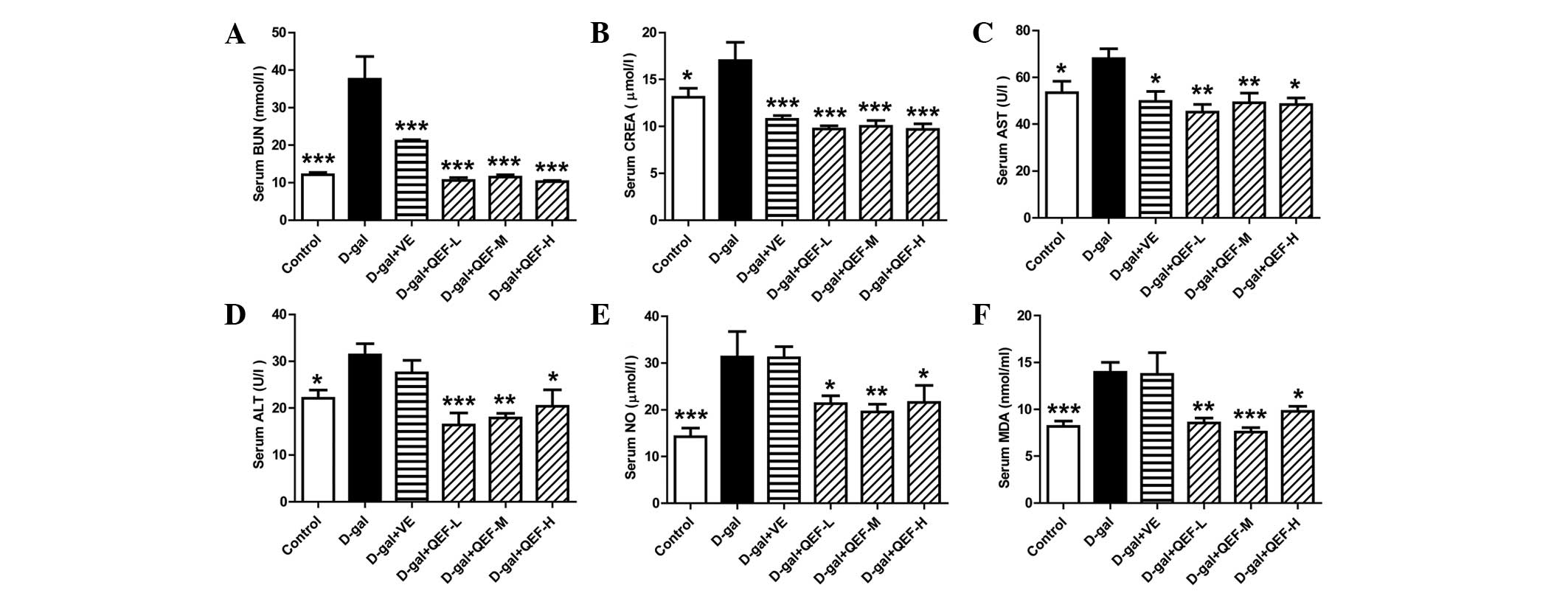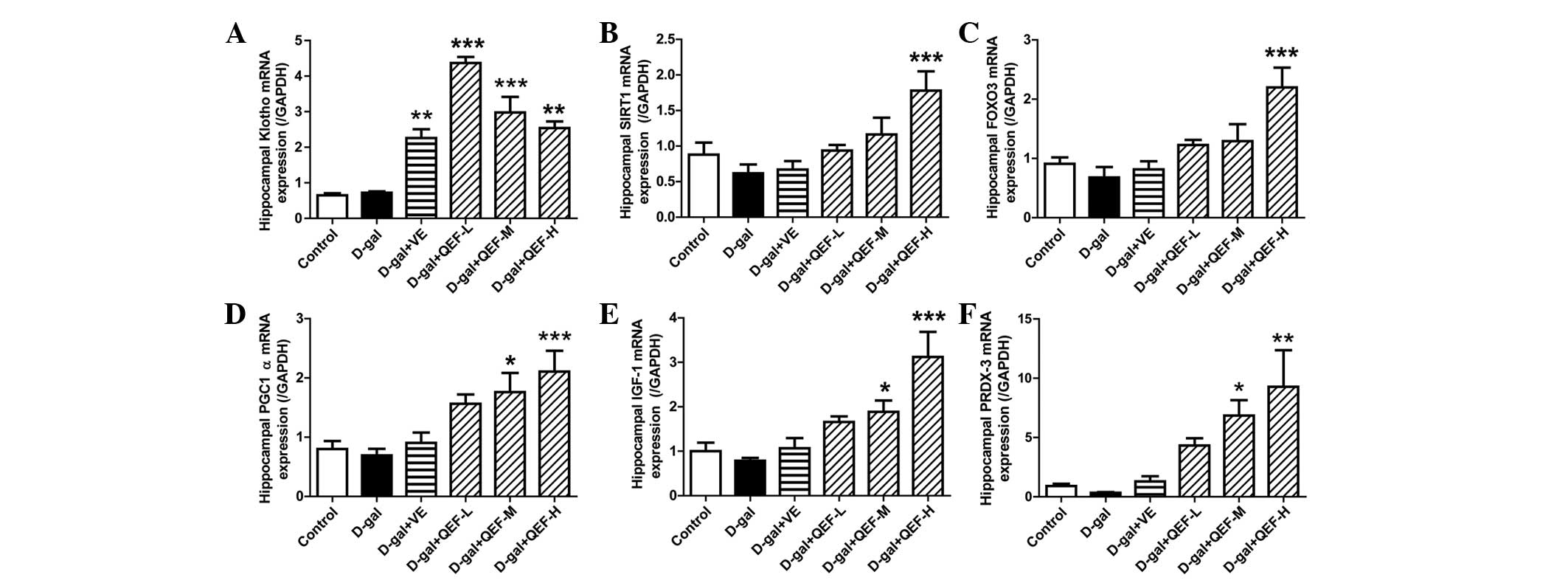|
1.
|
Jin K: Modern biological theories of
aging. Aging Dis. 1:72–74. 2010.PubMed/NCBI
|
|
2.
|
Lipsky MS and King M: Biological theories
of aging. Dis Mon. 61:460–466. 2015. View Article : Google Scholar : PubMed/NCBI
|
|
3.
|
Ho SC, Liu JH and Wu RY: Establishment of
the mimetic aging effect in mice caused by D-galactose.
Biogerontology. 4:15–18. 2003. View Article : Google Scholar : PubMed/NCBI
|
|
4.
|
Cui X, Wang L, Zuo P, Han Z, Fang Z, Li W
and Liu J: D-galactose-caused life shortening in Drosophila
melanogaster and Musca domestica is associated with
oxidative stress. Biogerontology. 5:317–325. 2004. View Article : Google Scholar : PubMed/NCBI
|
|
5.
|
National Pharmacopoeia Committee: Chinese
Pharmacopoeia. Beijing: Chemical Industry Press. 2010.
|
|
6.
|
Yang YP, Shuai B, Shen L, Xu XJ, Ma C and
Lv L: Effect of Qing'e formula on circulating sclerostin levels in
patients with postmenopausal osteoporosis. J Huazhong Univ Sci
Technolog Med Sci. 35:525–530. 2015. View Article : Google Scholar : PubMed/NCBI
|
|
7.
|
Xia Y, Zhao Y, Ren M, Zhang J, Wang Y,
Chang Y, Fu S, Fan G, Zhu Y, Huang Y, et al: A randomized
double-blind placebo-controlled trial of a Chinese herbal medicine
preparation (Jiawei Qing'e Fang) for hot flashes and quality of
life in perimenopausal women. Menopause. 19:234–244. 2012.
View Article : Google Scholar : PubMed/NCBI
|
|
8.
|
Xu Y, Zhang ZJ, Geng F, Su SB, White KN,
Bligh SW, Branford-White CJ and Wang ZT: Treatment with Qing'E, a
kidney-invigorating Chinese herbal formula, antagonizes the
estrogen decline in ovariectomized mice. Rejuvenation Res.
13:479–488. 2010. View Article : Google Scholar : PubMed/NCBI
|
|
9.
|
Huang F, Wang T, Lan Y, Yang L, Pan W, Zhu
Y, Lv B, Wei Y, Shi H, Wu H, et al: Deletion of mouse FXR gene
disturbs multiple neurotransmitter systems and alters
neurobehavior. Front Behav Neurosci. 9:702015. View Article : Google Scholar : PubMed/NCBI
|
|
10.
|
Kim S, Kang IH, Nam JB, Cho Y, Chung DY,
Kim SH, Kim JS, Cho YD, Hong EK, Sohn NW, et al: Ameliorating the
effect of astragaloside IV on learning and memory deficit after
chronic cerebral hypoperfusion in rats. Molecules. 20:1904–1921.
2015. View Article : Google Scholar : PubMed/NCBI
|
|
11.
|
Jansen EM and Low WC: Long-term effects of
neonatal ischemic-hypoxic brain injury on sensorimotor and
locomotor tasks in rats. Behav Brain Res. 78:189–194. 1996.
View Article : Google Scholar : PubMed/NCBI
|
|
12.
|
Karimi S, Hejazian SH, Alikhani V and
Hosseini M: The effects of tamoxifen on spatial and nonspatial
learning and memory impairments induced by scopolamine and the
brain tissues oxidative damage in ovariectomized rats. Adv Biomed
Res. 4:1962015.PubMed/NCBI
|
|
13.
|
Harman D: The free radical theory of
aging. Antioxid Redox Signal. 5:557–561. 2003. View Article : Google Scholar : PubMed/NCBI
|
|
14.
|
Uzar E, Koyuncuoglu HR, Uz E, Yilmaz HR,
Kutluhan S, Kilbas S and Gultekin F: The activities of antioxidant
enzymes and the level of malondialdehyde in cerebellum of rats
subjected to methotrexate: Protective effect of caffeic acid
phenethyl ester. Mol Cell Biochem. 291:63–68. 2006. View Article : Google Scholar : PubMed/NCBI
|
|
15.
|
Kurosu H, Yamamoto M, Clark JD, Pastor JV,
Nandi A, Gurnani P, McGuinness OP, Chikuda H, Yamaguchi M,
Kawaguchi H, et al: Suppression of aging in mice by the hormone
Klotho. Science. 309:1829–1833. 2005. View Article : Google Scholar : PubMed/NCBI
|
|
16.
|
Yahata K, Mori K, Arai H, Koide S, Ogawa
Y, Mukoyama M, Sugawara A, Ozaki S, Tanaka I, Nabeshima Y, et al:
Molecular cloning and expression of a novel klotho-related protein.
J Mol Med Berl. 78:389–394. 2000. View Article : Google Scholar : PubMed/NCBI
|
|
17.
|
Fon Tacer K, Bookout AL, Ding X, Kurosu H,
John GB, Wang L, Goetz R, Mohammadi M, Kuro-o M, Mangelsdorf DJ, et
al: Research resource: Comprehensive expression atlas of the
fibroblast growth factor system in adult mouse. Mol Endocrinol.
24:2050–2064. 2010. View Article : Google Scholar : PubMed/NCBI
|
|
18.
|
Wu H, Wang H, Zhang W, Wei X, Zhao J, Yan
P and Liu C: rhEPO affects apoptosis in hippocampus of aging rats
by upregulating SIRT1. Int J Clin Exp Pathol. 8:6870–6880.
2015.PubMed/NCBI
|
|
19.
|
Crandall JP and Barzilai N: Exploring the
promise of resveratrol: Where do we go from here? Diabetes.
62:1022–1023. 2013. View Article : Google Scholar : PubMed/NCBI
|
|
20.
|
Renault VM, Thekkat PU, Hoang KL, White
JL, Brady CA, Kenzelmann Broz D, Venturelli OS, Johnson TM, Oskoui
PR, Xuan Z, et al: The pro-longevity gene FoxO3 is a direct target
of the p53 tumor suppressor. Oncogene. 30:3207–3221. 2011.
View Article : Google Scholar : PubMed/NCBI
|
|
21.
|
Anselmi CV, Malovini A, Roncarati R,
Novelli V, Villa F, Condorelli G, Bellazzi R and Puca AA:
Association of the FOXO3A locus with extreme longevity in a
southern Italian centenarian study. Rejuvenation Res. 12:95–104.
2009. View Article : Google Scholar : PubMed/NCBI
|
|
22.
|
Xiong S, Patrushev N, Forouzandeh F,
Hilenski L and Alexander RW: PGC-1α Modulates Telomere Function and
DNA Damage in Protecting against Aging-Related Chronic Diseases.
Cell Reports. 12:1391–1399. 2015. View Article : Google Scholar : PubMed/NCBI
|
|
23.
|
Cox AG, Winterbourn CC and Hampton MB:
Mitochondrial peroxiredoxin involvement in antioxidant defence and
redox signalling. Biochem J. 425:313–325. 2009. View Article : Google Scholar : PubMed/NCBI
|
|
24.
|
Huffman DM, Farias Quipildor G, Mao K,
Zhang X, Wan J, Apontes P, Cohen P and Barzilai N: Central
insulin-like growth factor-1 (IGF-1) restores whole-body insulin
action in a model of age-related insulin resistance and IGF-1
decline. Aging Cell. 15:181–186. 2016. View Article : Google Scholar : PubMed/NCBI
|



















